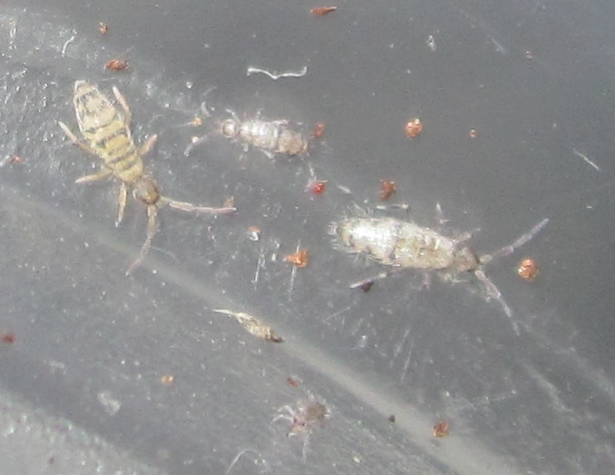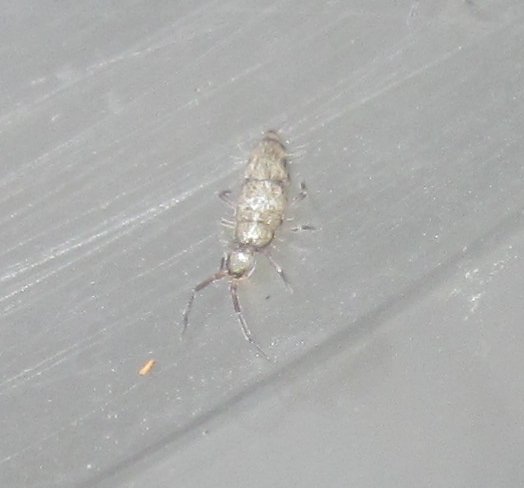First off, unfortunately I failed with establishing a culture of Entomobrya multifasciata. This is because, somehow when I collected them, I apparently also caught a couple Willowsia nigromaculata, which breed first and rapidly outcompeted the Entomobrya. I had thought they were simply denuded E.multifasciata at first, but apparently they were an entirely different species, one that was better suited to the setup I was using apparently... 😅 So, while this sucks for the Entomobrya, I do at least have a new springtail species period, one that was not actually being cultured by anyone else that I know of.
They seem to prefer decent ventilation, with a humidity gradient erring towards the drier side. Essentially they seem well suited to arid or at least semi-arid setups, similar to Entomobrya unostrigata. This seems to be a common theme with Willowsia, both W.buski and my cf. Willowsia "Kota Kinabalu" do well in those kinds of relatively low humidity levels.
Anyways, here are some pictures of the little intruders, and one of the remaining E.multifasciata in that culture:
 |
| Willowsia nigromaculata |
 |
| Entomobrya multifasciata |
 |
| E.multifasciata (L), W.nigromaculata (R) |
On a related note, I did in fact go out and collect some more Entomobrya multifasciata, and also removed the two remaining individuals in the now Willowsia dominated setup and threw them into a fresh setup with the new ones. So hopefully I can actually get a clean culture of those going soon. 😅
On another side note, in the same spot I found the new batch of E.multifasciata I also collected some brightly purple Lepidocyrtus, that I'll be referring to as Lepidocyrtus sp. "Violet" from here on out. Only found three this time but I'll be on the lookout for more, hopefully I can establish a culture of them. No pics ATM, but hopefully once they breed or I collect more I'll get around to getting some pics of a good group of them.
Next up, I've been exploring some relatively undisturbed (for now) scrubland habitat in Boise, Idaho for the past couple weeks, which has turned up some very exciting finds for me, (which I'll talk about more in a future post).
While I say undisturbed, there are accumulations or random junk here and there, and in one little patch of land there were a bunch of old, broken lengths of PVC piping. One of the pipes was broken in half and the bottom had been partially buried and filled with dirt. Swarming the walls on the inside of that pipe, and some of the lichen/moss covered rocks nearby was a tiny, black springtail species, which Frans Janssens identified as something in Isotomidae. I'll be referring to them as Isotomidae sp. "Black" from here on out. I obviously got my pooter out and suck up a whole bunch, so hopefully I'll get a culture established of these little cuties and spread them around to other hobbyists. 😄
I've got them set up in a well ventilated deli cup with a thin layer of coconut fiber mixed with crushed leaf litter at the bottom for substrate. Keeping them with a roughly 50/50 humidity gradient, and am using pieces of cardboard for hides. For food I'm sprinkling in pollen, chick feed and dog food crumbs.
Here are the best pictures of them I could get, these things are only a mm or so in length, very very small and hard for me to get decent pics of:
They look a bit grey in these photos because of the flash, but in person they are a dark, matte black. Very interesting little species, that I hope does well for me! Would be lovely to get an ID for them one day! 😄
Lastly, for years I've had a tiny Poduromorpha species in my collection, one that I think a lot of roach hobbyists have, (at least, certainly a lot of hobbyists who've dealt with Roachcrossing in the past, since they're one of the major distributors of this species in the hobby). They're currently known as Poduromorpha sp. "Tiny Blue", and seem to prefer nearly stagnant, quite humid conditions in organically rich substrate.
Anyways, I myself have started offering them for sale in limited quantities, as they're having population blooms in several of my Pyrophorini larvae cups. But I don't like putting stuff up on my for sale page without pictures... So I took the best pics of a clump of this species that I could, and figure I'll share them in this post, because why not? 😂
Here are the little cuties:
They kinda resemble nearly microscopic velvet worms IMO, pretty cute. 🥰 They're the same size or smaller than Lepidocyrtus sp. "Small Silver", so about a mm or so in length fully grown.
Well, that's gonna do it for this post! I've got SO many new additions to post about, but have been super lazy with taking and editing pictures lately, and haven't had a lot of motivation lately period. Trying to get back to posting more, so hopefully you'll get to see some of the new species I've gotten soon! 😅
As always thanks for reading, hope everyone enjoyed, stay safe, and I'll see you all next time! 😉





































































































